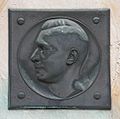St. Elisabeth Cemetery
The St. Elisabeth cemetery is a cemetery of the Protestant church in the vineyard in Berlin district of Mitte . The burial ground east of Ackerstrasse, which was laid out as an alley cemetery , was inaugurated in 1844. The cemetery with a size of 2.69 hectares is a registered garden monument .
Immediately adjacent, across Ackerstrasse, is Cemetery II of the Sophiengemeinde , which has been in use since 1827 .
In 1875 the St. Elisabeth parish laid out a second cemetery, St. Elisabeth Cemetery II , on Wollankstrasse in what is now the Gesundbrunnen district .
history
After the Protestant St. Elisabeth Congregation with the Elisabeth Church designed by Karl Friedrich Schinkel as its center was established in the early 1830s , the congregation set up a cemetery in 1843, which was inaugurated in January of the following year.
The area was four acres and divided into burial quarters by avenues lined with linden trees . In the area of the entrance, the community had a house built for the gravedigger near the entrance in 1846 based on a design by Johann Nietz , which later served the cemetery administration. The cemetery was expanded by ten acres as early as 1850. In this context, the second patron of the community, Friedrich Wilhelm IV , donated a cast - iron neo - Gothic cross from the royal iron foundry in 1851 , which was set up as a point de vue at the intersection of the main avenues.
The brick Gothic style cemetery chapel was built around 1884; the architect is not known.
For the construction of the Reconciliation Church , the cemetery area in the northern area was reduced in size in 1892. The Reconciliation Church stood in the border strip with the construction of the Berlin Wall from 1961. A small area of the cemetery, which was located directly behind and next to the church, was abandoned as part of the border fortification. The remains were reburied , the graves leveled and the remainder of the cemetery closed off to the north by a hinterland wall.
After German reunification , on January 1, 1999, the St. Elisabeth parish was merged with that of the Sophien parish under the name of the latter, so that the cemetery belonged to the Sophien parish. This in turn renamed itself at the beginning of 2014 in the parish on the vineyard .
Graves of famous people
There are no honorary graves of the State of Berlin in the St. Elisabeth Cemetery .
Well-known personalities buried here are:
- Lucie Berlin (1895–1904), murder victim in a spectacular criminal case (grave not preserved)
- Wilhelm Boegehold (1815–1873), theologian, first pastor at the Elisabeth Church
- Ludwig Erk (1807–1883), composer, music teacher
- Julie Gräbert (1803–1870), theater director (grave not preserved)
- Ferdinand Schmidt (1816–1890), writer, public educator (grave not preserved)
- Anna Stephan (1827–1862), first wife of Heinrich von Stephan (grave not preserved)
- Adolf Friedrich Wollank (1833–1877), landowner, lawyer, local politician
- Gottlieb Friedrich Wollank (1771–1851), landowner, manufacturer
- Karl Zimmer, pseudonym: Yoshitomo (1869–1935), composer, choirmaster, conductor (grave not preserved)
Works of art
architecture
Wollank burial site
The landowner and manufacturer Gottlieb Friedrich Wollank had an extensive hereditary burial site built at the end of the main avenue leading from the entrance from 1848 to 1850 . From 1873 to 1874 the tomb was renovated in the Italian neo-renaissance style.
The back of the sandstone complex consists of a false facade with two aedicules framed by pilasters . Only fragments of the statues standing in these have been preserved. The false facade extends with two fields into the side walls, which then merge into lower open segments supported by pillars. At the front, a wrought-iron grille with two entrances closes the hereditary burial, which the family still uses today.
Schmidt burial site
In the northwest corner of the cemetery is the hereditary burial place of the Carl Schmidt family. The survivors of the reindeer had it built from Cotta sandstone in 1913 . The building takes on a Doric temple shape, with the front being moved to the rear wall, creating an open, three - winged colonnade - like complex. The execution of the tympanum was unadorned; there is only the lettering "FAMILIE CARL SCHMIDT" under a cross. Since the system is located in a corner of the cemetery, the rear wall and left side were closed and only blind columns were built there . The areas created in this way between the columns on the back wall of the grave were used to record the personal data set with bronze letters.
For the flagjunker Gerhard M. Böttcher, who died in World War I , a bronze relief was also added to commemorate.
The tomb, with its three-sided enclosing pillars, is unique in Berlin.
sculpture
In the cemetery there are several historical grave sculptures made of bronze and stone as well as two grave reliefs of the buried. Except for the two sculptures in the Wollank grave complex, they are in a satisfactory condition. The sculptors of most of the works are unknown.
- Funerary sculptures
Prayers by Fidel Binz
- Grave reliefs
Grave relief Ludwig Erk, created by Josef Drischler
Web links
- Website of the Sophiengemeinde on the cemetery
- Entry in the Berlin State Monument List with further information
Individual evidence
- ^ List of Berlin cemeteries of the Berlin Senate Department for Urban Development
- ↑ a b Garden monuments in Berlin - cemeteries . Michael-Imhof-Verlag, Petersberg 2008, ISBN 978-3-86568-293-2
- ↑ Evangelische Kirchengemeinde Sophien - Fusion ( Memento from November 5, 2013 in the Internet Archive ), accessed on May 9, 2016.
Coordinates: 52 ° 32 '6 " N , 13 ° 23' 35.5" E











